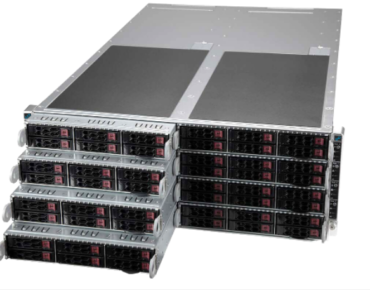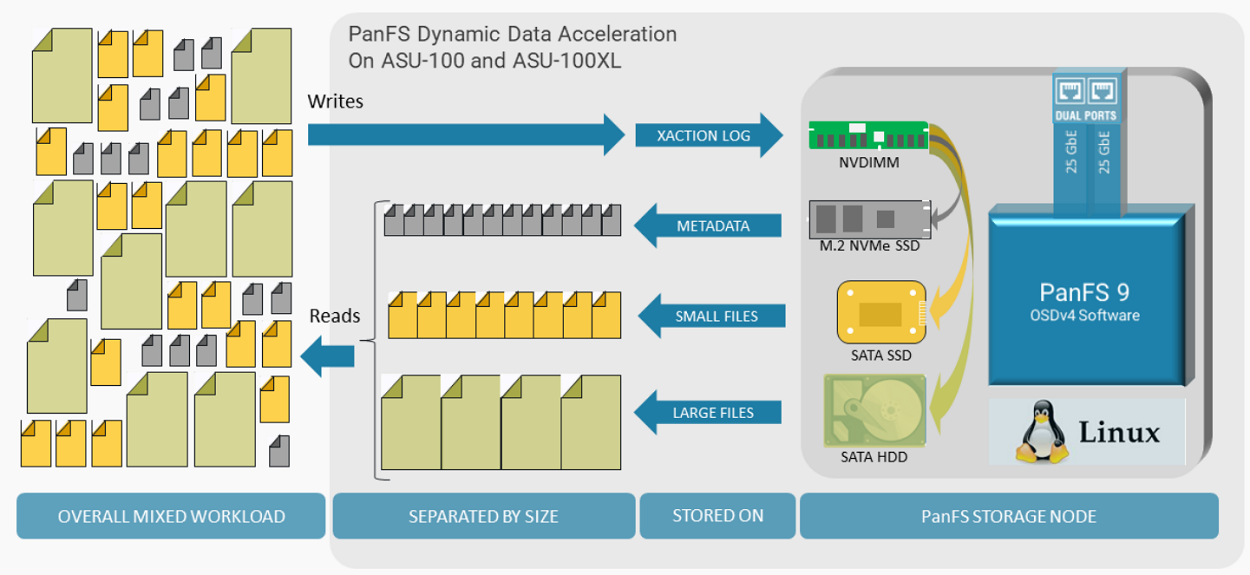Panasas Debuts New Products, Continues Software Focus

Panasas started off specializing in storage hardware, but more than 20 years on, the company is placing a big bet on its software stack to meet storage needs for high-performance applications.
The company on Wednesday introduced new storage products called ActiveStor Ultra XL and ActiveStor Flash for high-performance computing and artificial intelligence applications. The products are built on the company’s PanFS file system, which orchestrates data movement in large clusters deployed over a network.
The ActiveStor Ultra XL storage product has up to 5.76 petabytes of storage in a single 42U rack, while the all-flash ActiveStor Flash with NVMe (shown in the header) supports up to 368.64TB of SATA SSDs and 30.72TB of NVMe SSDs in a 4U rackmount chassis.
The PanFS file system talks with storage components over a network to handle large data sets. The file system, built on top of Linux, has components that include the DirectFlow client application, which is a loadable file system driver that lives on the compute node or a client’s computer; a director software stack, which runs on director appliances to handle metadata management and also keeps the system healthy by monitoring the storage cluster and cache coherency. A critical PanFS component orchestrates data and file movement at all nodes in the storage hierarchy.
 “I know what storage nodes hold what pieces of that file, goes out to talk to them in parallel, brings all the pieces back and then hands them to the application as if it was just an NFS request, but it’s not,” said Curtis Anderson, software architect at Panasas.
“I know what storage nodes hold what pieces of that file, goes out to talk to them in parallel, brings all the pieces back and then hands them to the application as if it was just an NFS request, but it’s not,” said Curtis Anderson, software architect at Panasas.
The PanFS file system can run under Kubernetes, Anderson said, adding “we provide a POSIX file system namespace that is, in technical terms, cache coherent across all the clients.”
In POSIX file systems, an application sees either the prior data or data that was written. “We have the same semantics, except across nodes,” Anderson said.
The new storage products are the first introductions to the company’s portfolio in more than 20 years. Until now the company sold one product, ActiveStor Ultra, which has seen many iterations.
“Prior to 2018 we were a systems company, after 2018 we are a software company,” Anderson said.
The company previously designed its own hardware as commodity parts weren’t available. But with storage now a commodity, the company anticipates to ship its software stack on other OEM platforms as high-performance computing computers typically want to buy the compute nodes, networking and storage from one vendor.
“When the customer wants to buy PanFS, they will buy our software pre-bundled with Supermicro hardware. That’s the platform we’re currently working with. We’re planning on expanding to other platforms,” Anderson said.
To make PanFS viable for commodity hardware, the company rewrote the software stack, which now runs on top of Linux after a port from FreeBSD.
“That was the big effort of getting commodity hardware — reorganizing all of that software stack into Linux,” Anderson said.
A technology called dynamic data acceleration, which uses data size to make a data placement decision, was built while shifting the storage stack to Linux. That is in comparison to a typical flash-and hard-drive storage stack in which “hot” data moves up to a faster storage tier and moves down when it cools off.
“The insight here is that hard drives are great at delivering performance if they do a seek and then a really large transfer. They’re terrible if they do a seek and small transfer. The key is to only put very large things on a hard drive. We have to put them somewhere so we put them on capacity flash. We segregate the metadata out so we know where everything lives, the [index nodes] and directories all that, [and] put that on to the low-latency NVMe flash. We can deliver about twice the performance per hard drive compared to our competitors because we’re doing this magic inside the storage stack,” Anderson said.
Mark Nossokoff, research director and lead storage analyst at Hyperion Research, commented on the Panasas products and new directions. “The latest additions to the Panasas product family are addressing a blend of complex storage requirements resulting from the convergence of traditional compute-intensive HPC modeling and simulation workloads with AI-driven data-intensive workloads,” Nossokoff told HPCwire.
“By enhancing PanFS and delivering it on standard hardware platforms … Panasas is aiming to provide a single storage solution capable of satisfying the required balance of price, performance, and feature needs regardless of the jobs being run.”
The pricing for ActiveStor Ultra XL and ActiveStor Flash varies depending on the customer, the company said.











